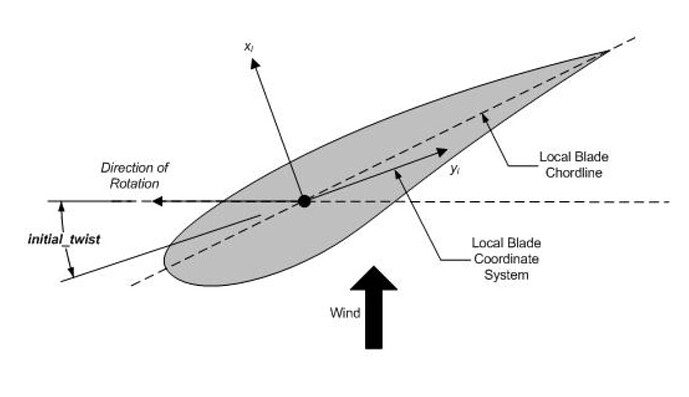I am using BECAS to obtain the 6X6 stifness and mass properties for BEAMDyn input. To work around the diferrent coordinate system convention the two use I adjusted the airfoil in BECAS so that the x-axis is along the flapwise direction pointing to the LP side and the y-axis is on the edgewise direction pointing to the TE. As seen here
I have to use a very small timestep (0.0001) along with a ‘NumCrctn‘ of 10 to have the simulation run without the following error
"FAST_Solution:FAST_UpdateStates:FAST_AdvanceStates:SrvD_UpdateStates:DLL_controller_call:BladedInt erface option was designed for an explicit-loose coupling scheme. Using last calculated values from DLL on all subsequent calls until time is advanced. Warning will not be displayed again. Time: 1 of 600 seconds. Estimated final completion at 22:52:20. FAST_Solution:FAST_UpdateStates:CalcOutputs_And_SolveForInputs:SolveOption2:AD_CalcOutput:RotCalcO utput:BEMT_CalcOutput(node 6, blade 3):UA_CalcOutput:UA_BlendSteady:Temporarily turning off UA due to high angle of attack or low relative velocity. This warning will not be repeated though the condition may persist. The BEM solution is being turned off due to low TSR. (TSR = 1.9628). This warning will not be repeated though the condition may persist. (See GeomPhi output channel.) FAST_Solution:FAST_UpdateStates:FAST_AdvanceStates:B1::BD_GA2:BD_DynamicSolutionGA2:Solution does not converge after the maximum number of iterations FAST_AdvanceStates:B2::BD_GA2:BD_DynamicSolutionGA2:Solution does not converge after the maximum number of iterations FAST_AdvanceStates:B3::BD_GA2:BD_DynamicSolutionGA2:Solution does not converge after the maximum number of iterations OpenFAST encountered an error at simulation time 1.019 of 600 seconds. Simulation error level: FATAL ERROR "
If I use however a small timestep along with the NumCrctn the simulation takes days to finish.
I believe that either one of the two matrices is ill-defined or I am doing something fundamentally wrong.
Dear @Theodoros.Varouxis,
Can you clarify more about your BeamDyn model set up? Do the keypoints in BeamDyn define a smooth or straight line? What order element are you using?
Best regards,
Dear @Jason.Jonkman ,
The keypoints are the following
kp_xr kp_yr kp_zr initial_twist
(m) (m) (m) (deg)
0.00000e+00 0.00000e+00 0.00000e+00 1.33080e+01
0.00000e+00 0.00000e+00 4.10000e+00 1.33080e+01
0.00000e+00 0.00000e+00 1.02500e+01 1.33080e+01
0.00000e+00 0.00000e+00 1.43000e+01 1.14800e+01
0.00000e+00 0.00000e+00 1.84000e+01 1.01620e+01
0.00000e+00 0.00000e+00 2.25500e+01 9.01100e+00
0.00000e+00 0.00000e+00 2.66500e+01 7.79300e+00
0.00000e+00 0.00000e+00 3.07500e+01 6.54400e+00
0.00000e+00 0.00000e+00 3.48500e+01 5.36100e+00
0.00000e+00 0.00000e+00 3.89500e+01 4.18800e+00
0.00000e+00 0.00000e+00 4.30500e+01 3.12500e+00
0.00000e+00 0.00000e+00 4.71500e+01 2.31900e+00
0.00000e+00 0.00000e+00 5.12500e+01 1.52600e+00
0.00000e+00 0.00000e+00 5.74000e+01 0.37000e+00
0.00000e+00 0.00000e+00 6.15000e+01 0.00000e+00
the WT is the NREL 5MW reference turbine and all inputs have been derived from here “Definition of a 5MW/61.5m Wind Turbine Blade Reference Model (https://www.osti.gov/servlets/purl/1095962)“
as for order element I am using 10
Thank you for your time and consideration
Theo
Dear @Theodoros.Varouxis,
A BeamDyn model of the NREL 5-MW baseline wind turbine is available in the OpenFAST r-test: r-test/glue-codes/openfast/5MW_Baseline at main · OpenFAST/r-test · GitHub. It looks like your key point definition is similar (albeit a bit coarser) than what has been provided. How do the mass and stiffness matrices compare?
Best regards,
How do your
Going at a random station (say 0.433 of balde length)
This is the BECAS derived mass matrix
| 23.04143 |
0 |
0 |
0 |
0 |
-0.563004751 |
| 0 |
23.04143 |
0 |
0 |
0 |
0.528271055 |
| 0 |
0 |
23.04143 |
0.563005 |
-0.52827 |
0 |
| 0 |
0 |
0.563005 |
2.318434 |
-0.02049 |
0 |
| 0 |
0 |
-0.52827 |
-0.02049 |
0.097328 |
0 |
| -0.563 |
0.528271 |
0 |
0 |
0 |
2.415761703 |
And this is the one found in the beamdyn manual
| 294.734 |
0 |
0 |
0 |
0 |
-44.1924 |
| 0 |
294.734 |
0 |
0 |
0 |
0 |
| 0 |
0 |
294.734 |
44.19242 |
0 |
0 |
| 0 |
0 |
44.19242 |
263.87 |
0 |
0 |
| 0 |
0 |
0 |
0 |
62.67 |
0 |
| -44.1924 |
0 |
0 |
0 |
0 |
326.54 |
And this is the one in the provided link
| 294.734 |
0 |
0 |
0 |
0 |
0 |
| 0 |
294.734 |
0 |
0 |
0 |
0 |
| 0 |
0 |
294.734 |
0 |
0 |
0 |
| 0 |
0 |
0 |
263.87 |
0 |
0 |
| 0 |
0 |
0 |
0 |
62.67 |
0 |
| 0 |
0 |
0 |
0 |
0 |
326.54 |
I do not know what to make out of it, as the stiffnes properties are similar in magnitude while the mass properties are not
Dear @Theodoros.Varouxis,
The OpenFAST r-test uses a simplified BeamDyn model of the NREL 5-MW baseline turbine whereby the off-diagonal elements of the mass and stiffness matrices are zeroed so as to make the BeamDyn model more similar to the ElastoDyn model.
I’m not sure why your BECAS mass matrix is so different, but that sounds like it could be the source of the original issue you were reporting.
Best regards,
